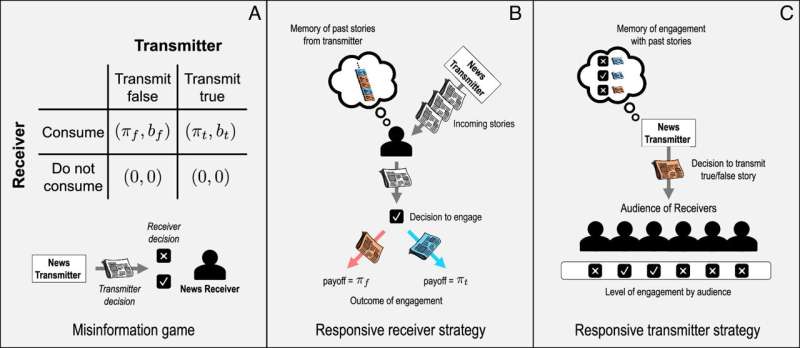This article has been reviewed according to Science X's editorial process and policies. Editors have highlighted the following attributes while ensuring the content's credibility:
fact-checked
peer-reviewed publication
trusted source
proofread
New research shows how attention lapses are exploited by fake news sites

Think before you click. That's the advice from Alexander Stewart, Professor in the School of Mathematics and Statistics at the University of St Andrews, whose research indicates inattentive readers are more likely to click on a false news story, with misinformation content producers exploiting this attention gap.
The paper, titled "The distorting effects of producer strategies: Why engagement does not reveal consumer preferences for misinformation," co-authored by Antonio A. Arechar of the Center for Research and Teaching in Economics in Mexico, David G. Rand of MIT, and Joshua B. Plotkin of the University of Pennsylvania in the U.S., and published in Proceedings of the National Academy of Sciences, outlines a game-theoretical approach to understanding the interplay between the role of online news readers, or consumers, and content producers.
"We know false news stories can spread more quickly than factual content," says Alex, "and we know how damaging they can be to public discourse and trust in democratic institutions. However, much of the previous research in this area was empirical in nature with very little formal modeling. We wanted to apply game theory to learn more about the dynamics between consumers and content producers."
The consensus that consumers of false content are actively pursuing stories that align with their beliefs assumes consumers have full agency over their choices, however the results of this study demonstrate strategic intent from the producers of false content can draw in otherwise truth-seeking readers.
"By studying the strategic interactions between consumers and the news sites they access and share, the study shows how transmission strategies from content producers play a role in luring normally truth-seeking consumers into engaging with misinformation," adds Alex.
"Our work demonstrates that while most people actually prefer to engage with and share factual information, when they are tired, overwhelmed, or just plain lazy, they're less likely to think about the veracity of a news story, and can get stuck into habits where they click on more stories from sites producing misinformation."
This effect can be particularly important when online media production focuses on a particular topic, for example during election cycles, leading to readers inadvertently clicking on links from sites they would not otherwise go to for their news content.
"Our model demonstrates that producers can exploit the habits of inattentive readers who have engaged with their content previously, by exposing them to increasing amounts of false news over time," says Alex. "Once readers disengage with this misinformation sites, we predict a more balanced production of stories re-emerge, both factual and false."
The importance of simple online literacy, such as checking sources, reading beyond a headline before clicking and/or sharing cannot be understated. Of course, consumers are exhausted, a state of play which will be easier for producers who want to lure consumers in with fake news to exploit.
Given the current political climate, with 50 countries set to hold elections in 2024, including in the U.K. and the U.S., opportunities for spreading misinformation are likely to increase and the online landscape will become a hotly contested battleground for partisan interests.
More information: Alexander J. Stewart et al, The distorting effects of producer strategies: Why engagement does not reveal consumer preferences for misinformation, Proceedings of the National Academy of Sciences (2024). DOI: 10.1073/pnas.2315195121
Journal information: Proceedings of the National Academy of Sciences
Provided by University of St Andrews




















